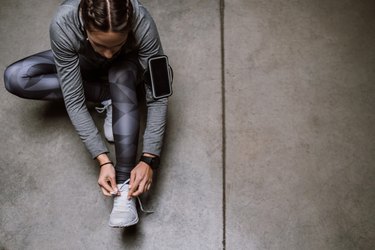
When buying running shoes, choosing a pair based on size alone won't always get you the best fit. The impact of running causes your foot to splay and your toes to push forward, so it's important to purchase a pair that has enough room to accommodate these movements.
Running shoes that are too tight can cause blisters and toe pain from rubbing, friction and moisture, while shoes that are too loose may cause your foot to slip, leading to ankle or knee injuries.
Video of the Day
Video of the Day
Understanding which areas of your shoe could use more room versus areas where they should be more snug and secure can help you find the best fit for your run, according to the American Academy of Orthopaedic Surgeons (AAOS).
Here, we break down how much room your running shoes should have to help you find the perfect pair.
How Much Room Should You Have in the Toe Box of Running Shoes?
During a run, your blood flow increases, and the impact of each strike causes your foot to swell. To accommodate this, your running shoes should have extra space in the toe box — about a finger's width of space between your longest toe and the end of the shoe — according to the American Heart Association. Essentially, you should be able to wiggle your toes when running in your shoes.
But some people may need even more room in the toe box. For instance, people who have bunions or hammertoes need shoes with a wide toe box to allow their feet to splay and accommodate the prominences (find out how to prevent your toes from curling inside your running shoes).
How Much Room Should You Have in the Upper of Running Shoes?
A flexible and breathable upper that fits like a glove will provide you with stability and comfort. The upper of your running shoes should be comfortably snug without being so tight that you can't tie the laces, or it becomes painful to wear while running.
If you find a shoe that fits well but feels a bit too loose or too tight at the upper, different lacing styles can help change how the shoe conforms to your midfoot.
How Much Room Should You Have at the Heel of Running Shoes?
A shoe that is too loose or too tight at the heel will leave you with blisters, even after a short run. When trying on shoes, lace them up and walk around. If you feel the shoe slipping around at the back of your foot, the shoe is too large. The heel should also not feel tight or restricted with the shoe laced up. There should be an overall snug feeling at the back of your foot, according to the American Podiatric Medical Association (APMA).
When shopping for running shoes, you should also make sure there's a heel counter, which is a stability feature that holds your heel in place, per the AAOS.
3 Shopping Tips for Buying Running Shoes
1. Try On Shoes at the End of the Day
When shopping for running shoes, wear the type of socks you normally wear on a run and go in the late afternoon. Because your feet swell throughout the day, you'll get a better sense of how the shoe will fit during a run, according to the AAOS.
In many cases, the size of your running shoes tends to be slightly larger than your everyday shoes to accommodate the impact and movement (here's how to measure your feet for running shoes). This is especially true if you're adding your own insoles or orthotics, so it's best to try on different pairs to figure out the right fit. It's also helpful to do a trial run on the surface you run on most often.
2. Find the Right Support
Choosing the perfect pair of running shoes for you depends a lot on your foot type. People who have flat feet often overpronate (when your ankle rolls inward excessively), while those who have high arches are more likely to supinate (applying too much weight on the outside of the feet), according to the APMA. People who have neutral feet are somewhere in between flat footers and those with high arches.
People who overpronate may need stability running shoes with motion control to help secure their feet, and people who suplinate may benefit from wearing running shoes with cushioned and flexible midsoles to provide support for the arch, per the APMA.
3. Consider the Terrain
If you do most of your runs on the road, then the average running shoe should suit most of your needs. But if you're running on trails or bumpier terrain, you want to choose trail running shoes that have more durable outsoles and better traction.
Depending on your preference, you may also want more bounce and cushioning in your stride to protect your knees or a low stack height that gets you closer to the ground.
Running Shoes FAQs
How long does it take to break in running shoes?
Your running shoes should fit properly right out of the box, so ideally, there shouldn't be much time to break in the fabrics.
How often do you need to replace your old running shoes?
Most experts recommend replacing your running shoes every 300 to 500 miles, according to the American Council on Exercise. But if you notice that your soles are worn out or thinning and they don't have the same amount of support they used to, then it's time to swap them out.
- American Academy of Orthopaedic Surgeons: "Athletic Shoes"
- American Heart Association: "Get the Right Sneakers for Your Workout Infographic"
- American Podiatric Medical Association: "Running Shoes: Basic Guidelines"
- American Academy of Orthopaedic Surgeon: "Shoes: Finding the Right Fit"
- American Council on Exercise: "Are Your Wearing the Right Shoes for Your Workout?"
- REI: Running Shoes -- How to Choose